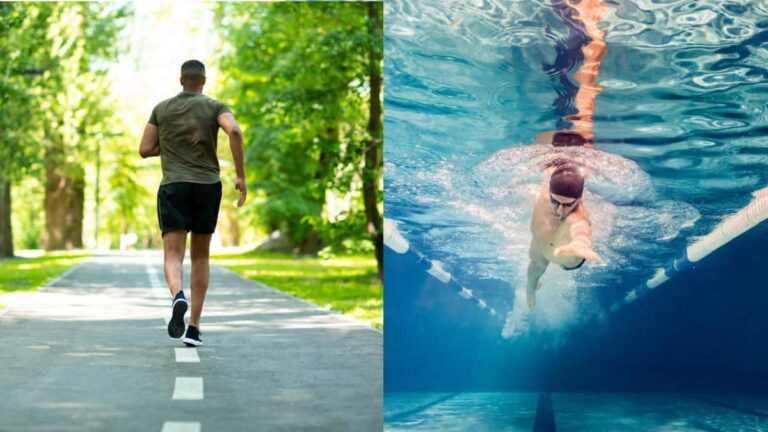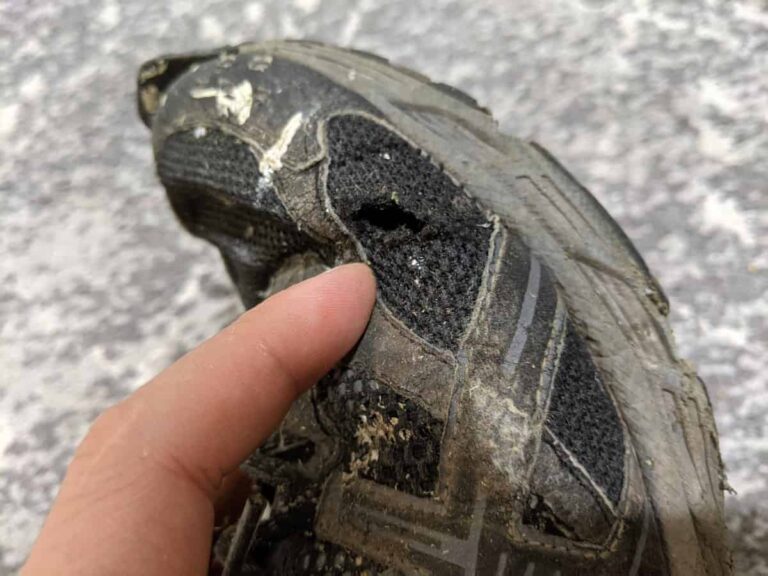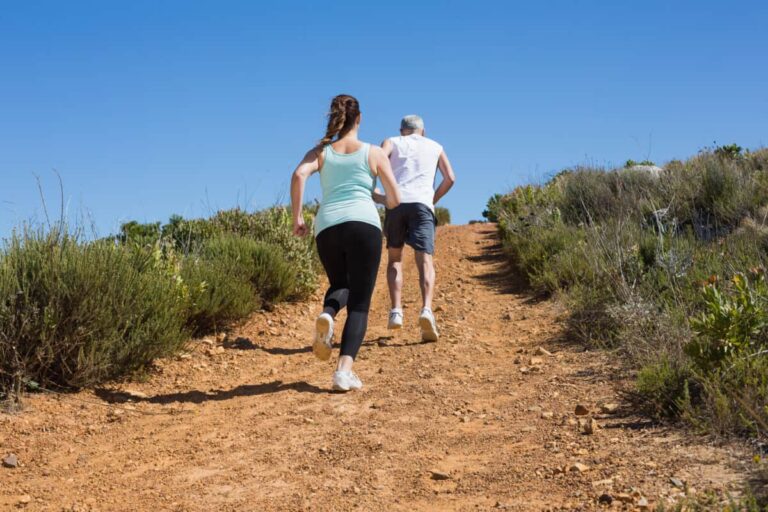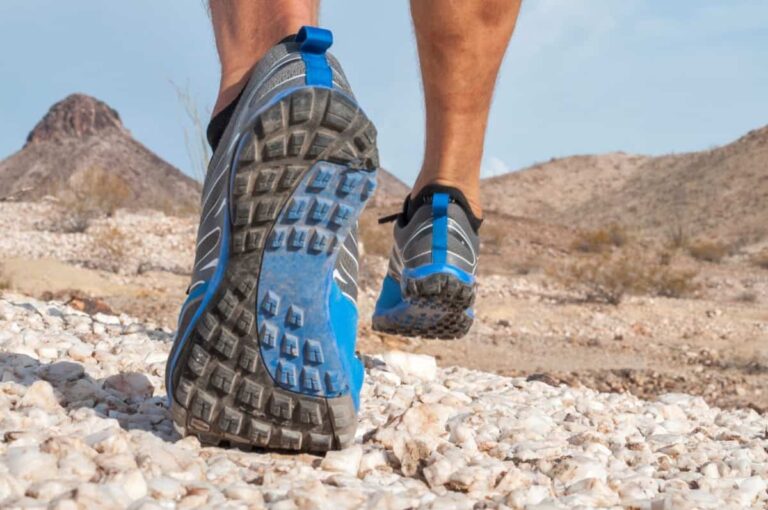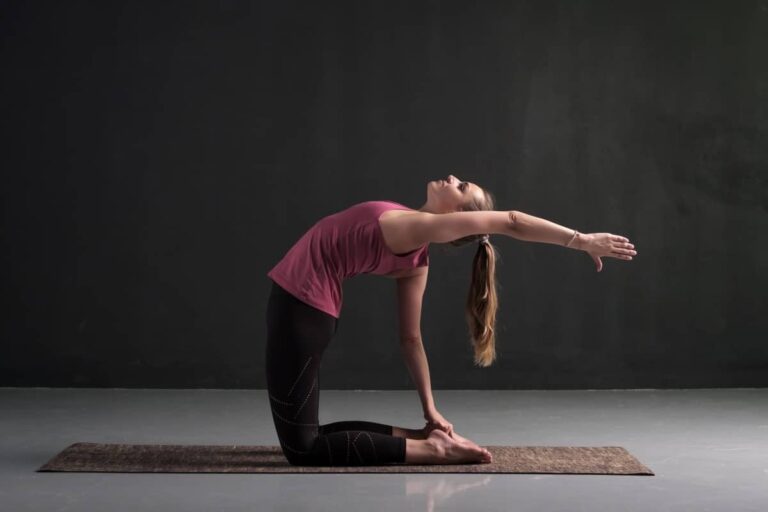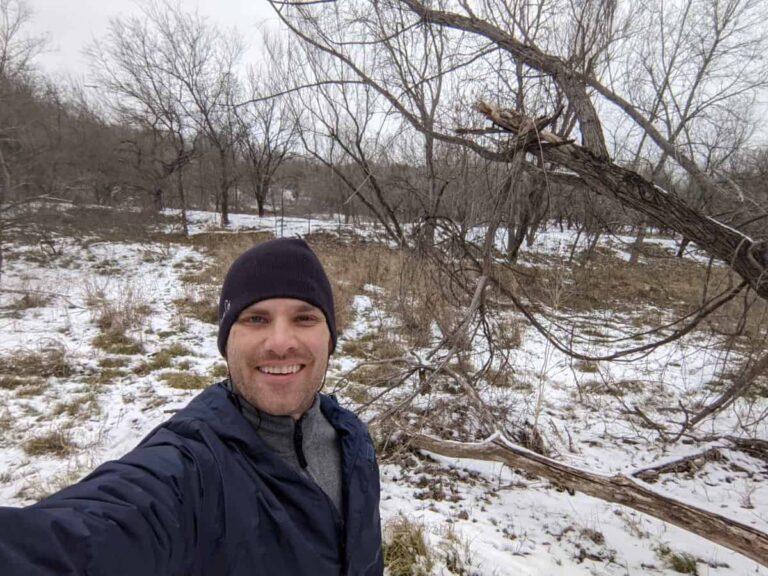How to Run in the Snow (Without Slipping)
If you’re like me, then you might feel like willpower is not a constant friend and a bit of bad weather may be a welcome excuse to skip a run. Or two. But absence through a season of snow is not an option, and sooner or later, you have to face the flakes. But running in snow brings the risk of slipping – and performance-stopping injury. Is there a way of surging safely through the winter?
Running safely through the snow requires adaptations in gear, running style, terrain, and timing. Indoor running helps. These modifications reduce but don’t eliminate the chance of a fall. Extra measures to limit the impact of a fall include social accountability and exit strategies.
It is important to consider the nature and dangers of snow from a runner’s perspective. We’ll include some motivation to get out there even when all you see is cold snow out your window. But first, let’s talk about how to run in the snow.

How To Run In The Snow
There are some popular options for running in the snow. Some include actually not running at all! Your options range from when you go, through what you wear, to how you run. Below are ten tips that are the least controversial out of the clamor of opinions.
Running Snowshoes
Snowshoes are shoes designed to hike through snow. They have been around the cold climes for centuries, and have been modernized only as recently as the 1970s. Don’t worry, I’m not suggesting strapping on those giant snowshoes that you might have in your mind. Nowadays there are running snowshoes.
A little bit of background:
Snowshoes have cleated arches that describe an ellipse around the edges of the shoe, creating a considerably expanded, studded footprint. This larger footprint reduces the risk of falling over, and the studying helps grip the snowy terrain. The design spreads out your body weight by spreading the points of traction over a wider area.
Regular snowshoes require an unusual gait– somewhat like stepping with the duck hunter’s waders. This places strain on running legs and makes turning particularly difficult. And I don’t know if you’ve ever been snowshoeing, but it’s absolutely exhausting, and … to me… not very fun. Not sure why people do it.
To preserve something akin to the runner’s gait, however, special running snowshoes have been developed, with deviations from the clunky hiking variety. The bows tack much closer to the shoe, creating a smaller surface area. They are lighter, with fewer cleats. Finally, they fit more snugly into the shoe, reducing the flop that characterizes hiking snowshoes.
The decking on running snowshoes has either a one-piece molded composite deck free of rails or an aluminum frame with rails. Typically, the rails attach to a fabric deck with plastic coating.
If you’d like to see some examples, check out these from trailrunningmag.com.
Cold-resistant binding fit the frame to the shoe. This is adjustable for comfort. Direct Mount Bindings are considered the best for long-haul runners. Test the binding of your choice as the shoes can pop off unexpectedly if not the right fit or design for you.
Added features are grips and braking bars built into the body of the shoe. Aluminum varieties offer added lightness.
It is advisable to practice small runs before stepping out for a workout. In spite of the modifications for runners, these shoes do take some getting used to.
Traction Cleats
These are accessories to transform a normal pair of running shoes into snowshoes. This approach has the advantage that the runner gets the benefits of her go-to shoe throughout the training season. There is less of a need to make gait adjustments for the unwieldy snowshoe.
Cleats are straps or chains that slip over a pair of shoes. The outsides of the cleats are fitted with spikes or studs – depending on the design – to provide traction in the snow. Spiked designs have the advantage of breaking the ice. They offer a trade-off between smaller spikes for mobility and larger spikes for performance in harsher terrain.
Some versions of cleats serve hiking and some jogging. While older people have used cleats for mobility and injury prevention over time, recent improvements in design have made them attractive to younger people. The different varieties offer varying levels and trade-offs of comfort and utility. Branded cleats are found online and are widely reviewed.
In the hubbub of the hiking and running crowd, there’s kind of some controversy on these– some people complain of these breaking so just know that it might not work perfectly for your shoe, the kind of running you’re doing, and the terrain.
Screw Shoes
Screw shoes are roll-your-own snowshoes. The idea is simple – create traction by affixing screws to a pair of trainers. For the cost of a dollar and a walk to the local hardware store, you can reduce your chance of slippage.
Head over to the store and get sheet metal or hexagonal screws. The raised heads form studs that provide the sought-after traction. Flat screws might look elegant, but they’ll do no more than create pores in a decent pair of well-loved sneakers. Be guided by the thickness of your sole. You want screws that will protrude barely through the sole. The inner lining and thicker, cold-resistant socks will protect your feet from the screw points. Buy plenty as you may need replacements.
Next, you’ll need a pair of pre-loved sneakers with some life left. Be sure that the sole is not worn and that there’s the sufficient inner lining. You’ll need to cushion your foot from the studs that weren’t there before. Screws are a snow-time stopgap, so we don’t want to drill through a new pair of top-end shoes. At the same time, they should not be so worn that they fail to function as running shoes – your joints still need impact protection.
On the underside of the shoe, mark points at which you’ll affix spikes. Some points to consider:
- Avoid air pouches if you have any. (Preferably, pick shoes that don’t have them.)
- There is no magic number of screws, but you want a spread of them all along the forefoot and heel of the shoe.
- Search online images of cleats and snowshoes for pattern inspiration.
- Surface area is your friend. Be sure to get close to the edges so that you have traction over as broad a total area as possible.
Screw the shoes into the sole with the head pointing out. Tighten all the way with the head protruding. Lace-up and run.
Check out skyrunner.com to see an example of a screw shoe.
Be a Pathfinder
Not all snowy paths are equal. This certainly applies to slippage risk as well. The key is to avoid the riskier paths and detect and return to the safer ones. A little bit of discernment can save the observant runner some injury. We offer four keys to treating different paths differently.
Knowledge
Get intel. Local media might have fine-grained snow reports showing the differential snowfall in your area. Online resources like snow-forecast.com offer detailed coverage. Find a resource that covers your area.
Build up knowledge of local conditions as you run. If you are new to an area, find a local running club – or enthusiasts you may meet by chance – and learn from them about snow patterns in the area.
Another option is before committing to an area for a run, go for a walk! You’ll get a great feel for the area before trying it out.
Importantly, the slippage risk depends on the ground on which the snow falls. Ice formation on grass and earth paths is less likely than harder surfaces. Use your knowledge of the underlying surface to know where the snow with traction likely is.
Cleared Paths
Snow doesn’t have the last say as to where it stays. Some areas are likelier to be cleared than others. College campuses are unique in that they have a large surface area, large foot traffic, and independent maintenance budgets. This combination ensures that they do not have to ration snow-clearing infrastructure with the city and clear their high-use pathways sooner.
Schools – particularly elementary schools – are similarly high-clearance areas as school administrators are risk-averse and need to clear access paths for students, teachers, and parents.
Maintenance roads may be harder to find, but do use them if they’re available. These are the pathways that accommodate salt trucks and plows, and they are therefore clearer of ice.
By using a combination of these, you can maximize the snow-free surface on your total run. Be prepared to sacrifice interesting views for the safety of snow-free circuits – Spring will restore the views, don’t worry.
Learn To Love Trails
Trails are not scooped, which results in a higher concentration of snow than ice, in contrast to urban roads. The variability in terrain offers a greater chance of finding pathways that are not massively compacted by snow.
Learn Your Snow
The famous 50 Inuit words for snow contain a tip: learn to identify the different permutations of ice, snow, and compactness. Dusting and slushy snow are slick but not as risky as icy and packed snow. If you’re not a trail runner – or skier – learn how to differentiate the types and find them on the trails.
If you are a trail runner, remember that the presence of snow alters the profile of the path. So, your mental map of variability in path segments might need an update.
With use, the trail snow compacts and the footwear described above becomes useful in getting more traction. In my personal opinion, learning to navigate and figure this out is really satisfying–you feel like you can beat the winter without letting it get you down.
I don’t know all 50 Inuit words for snow, but here’s what I do know:
- Fresh snowfall: Is mostly safe to run on when you’re running on flat terrain, although it may be the most difficult physically to run on. I personally think that if powder is a bit wet it will compact as you run on it and give you traction and a place to launch off of.
- Slush: As far as slipping, slush can be extremely slick depending on what it’s on top of. Furthermore, slush is very wet and unless you wrap your feet correctly will drench your feet. You can actually be in danger of frostbite if you get lost or otherwise take longer on your run than what you are thinking of. Avoid if possible.
- White ice: Any ice is really dangerous, but at least this is the kind you can see a bit more easily–but sometimes not. Avoid if possible.
- Black Ice: This happens on roads sometimes and it can be deadly because you are running on a very hard surface and you might not see it unless you’re watching for it. Avoid if possible.

Dynamic assessment
After you’ve decided on a path, keep an eye on the road as there may be variations in the snowfall. Prefer fresh snow over snow that is already compacted. Look out for ice and prefer snow. Better traction is obtained from fresh snow, which reduces the chances of slipping and getting injured. and injury.
But snow is highly reflective, and a combination of fallen snow and sunshine can be blinding. Manage glare with appropriate eyewear. You want enough protection from the sun’s harsh reflection – enabling you to look ahead – but not so much shading that you can’t discern differences in the snow ahead of you.
It feels weird to have sunglasses when it’s cold and cloudy, but it really can help–it’s no joke to be blinded by the white snow all day long.
Adapt
You cannot tame the snow, but a key to managing snow risk is making yourself a safer runner. There are four areas in which injury-saving tweaks can take you through the snow.
Distance
The first key to cutting risk is reducing your exposure to risky surfaces. Mix up your schedule so that more of your long runs happen indoors, saving the shorter ones for the snow.
If you ask my opinion, you’re going to be working a lot harder working on slick snow anyway, so you can run a shorter distance and get just as exhausted.
You can run a safer route over a shorter distance multiple times rather than one long route that has more uncertainty.
Speed
Go slow in the snow. Running more slowly gives more time to react if a slip does happen. If you’re sprinting, you won’t have the same reaction time to stop your slip from turning into a fall. Slowing also reduces injury risk, as you hit the ground with less impact force than had you been running faster.
Foot landing
Inspired by Runnersworld here:
Two adjustments to foot strike further reduce the risk of landing face-first in the snow.
First, ensure that your foot lands underneath your body, not in front of you. Landing this way places the foot underneath the center of mass, minimizing the forward vector forces on it. If you do slip, there’s not much force propelling the foot forward. In contrast, a foot that lands in front of you shoots out when it hits a slippery surface, propelled by the mass of your body bearing diagonally down upon it.
A second adjustment involves increasing your cadence. This is the number of steps your foot takes in a minute. Increasing the cadence, with your feet landing underneath you has two immediate knock-on effects:
- You take smaller steps. This, in turn, leads to more stability overall.
- You minimize ground contact time. Feet cannot slip if they’re off the ground.
Taken together, these adjustments lead to a lighter, less lumbering running style that is safer for wet surfaces. It also turns out this is what endurance runners do, anyway.
High Knees
In thicker snow, you need to lift your knees higher. This behavior will come naturally to many runners and is good practice for the glutes and flexors that drive running under normal circumstances.
For runners inclined to keep their knees low and fight the snow by driving their feet forward through the pile, note the following:
- This form wastes energy, and the motion is not functional (for running at least), as it does not stress muscle groups in a way they’re deployed in running.
- The extra ground contact time increases the risk of a slip.
- Forging like this requires lateral force on the ground from the landed leg. That is asking for a slip. In contrast, high knees drive the resting leg vertically into the ground.
If you run with high knees, you’ll agree with me, quickly–that a run in the snow doesn’t need to be far as a normal run would be. It’s exhausting.
Warm Up!
There’s some controversy as to whether warming up actually helps you avoid injury–but according to this study, at least, shows that warming up can enhance muscle contraction.
If nothing else, warming up will make that initial part of the run less miserable as you’re running in the cold and get your body literally warmed up.
Glute kicks, Soldier Walks, and Burpees are go-to warmup routines.
Fuel Up!
During running, the body uses large amounts of water, and even short spells on the road can leave a runner dehydrated.
Because we feel cool and don’t sweat during the winter, we lose an important cue to rehydrate. The lack of sweat does not mean that you’re not losing water. In fact, the body struggles to maintain internal temperature during the cold, and these homeostatic adjustments use more water. To make things worse, the cold weather might incline us to drinks that make us want to pee (like coffee).
By neglecting hydration, you increase the stress on your body. This makes it harder to carry out the balancing act of moving on top of the snow.
Timing
Schedule late morning runs when the sun is out. There is a greater chance of melting by the time of your run, and you don’t want to beat the snow shovels and salt trucks to the road.
Be opportunistic in rescheduling runs. On a surprise sunny day, bring forward an outdoor run if one has not been scheduled for the day. Catch up on canceled indoor training when the blizzards strike.
Reduce the duration of your outdoor runs. The less time spent outdoors, the less time opportunity for a fall.
Planning for the Worst Case Scenario While Running In The Snow
The preventative measures don’t reduce your risks to zero. Below are steps that anticipate a fall.
Run in Groups
If possible, don’t run alone. Having someone on hand to note your distress will help. Joining a local running club is an excellent way to slot into scheduled group runs.
Be Road Safe
Apart from the differential snowfall, roads also can be different in other ways.
- Pick roads that have some pedestrian traffic. This is another reason to run close to schools or college campuses. It may cost you some blushes, but this increases the likelihood of you being seen when you fall. In the event of an incapacitating fall, you will not go unnoticed.
- Avoid running next to busy roads. Visibility is poorer during grey, snowy weather, and falling down adjacent to a busy road during low-visibility conditions is really risky.
Maintain an Exit
Carry cash, a telephone, and or a ride-hailing app. Even a moderate injury might make a run back home a bad idea. If taxi access is erratic after hours, time your run accordingly. Being stuck 10 miles from home in good weather isn’t super convenient, but having a sprained ankle in the snow could be dangerous.
Be Accountable
Make a point of telling someone where you’re going and when you expect to return. If you have a smartphone, run with live tracking.
Dress Up
Apart from the snow, guard against the cold. Falling is just one injury vector. Hypothermia is another. When injured, you will have more exposure to the cold than anticipated – some of it possibly in a state of immobility. Warm layering will help in these conditions.
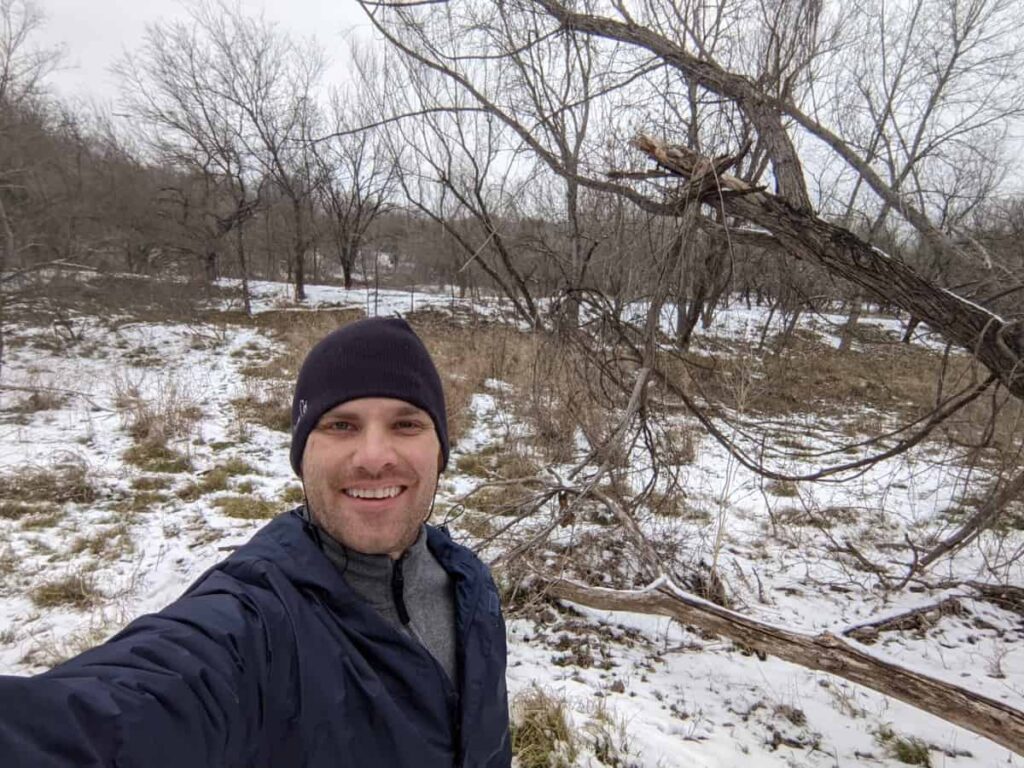
Practice Falling
Martial arts like Aikido, Jiu-jitsu, and Judo teach falling. You do not have to claim expertise in the martial aspects to learn this useful skill. Many falling injuries are not due to head trauma but stress injuries to the wrist and hands. These are brought about by attempts to stop the fall.
Learning proper braking techniques – which involve rolling to distribute the area of contact and soften the moment of impact – protects joints and sensitive areas during the fall, minimizing injury and immobility.
And if you are going to fall – aim for the snow.
Recover
After recovering from the embarrassment of the fall, attend to the injury itself. Stress injuries get worse if untreated.
By managing exposure to the snow, the runner can maintain continuity in training during difficult weather. As an added bonus, the snow holds some benefits that might be harder to obtain during summer weather. A methodical approach to managing snow risk beats fear and avoidance. And lazy winter fat.
Why Not stay indoors?
Training requires consistency, and staying off the road for a whole winter generally is not an option for the serious runner. If you live in a clime with harsh winters, hitting the road means hitting the snow.
While you may well be able to adjust your own training schedule, you cannot alter the timing of races. And some of your favorite trail races may fall in the winter or spring – when parts of the trail are covered in sleet.
But this is not all bad, as running in the snow has some advantages:
- Your metabolism is stoked by the cool weather. An essay published in the European Journal of Applied Physiology shows that exposure to cold temperatures increases resting metabolism.
- Cold weather burns calories. This research study discusses how exposure to extreme cold inclines the weather to produce brown fat rather than white fat. Brown fat tends to burn rather than store calories. For this and the reason above, cold exposure is cited by scientists as a weapon in the arsenal against obesity and diabetes.
- Running in snow boosts your form. Proper running form is critical for efficient running, and trudging through snow is beneficial in two form-related ways:
- Knee lift: Running through thick snow requires the knee-lifting drive. This trains away the shuffling impulse which ruins our running.
- Overstriding: Keeping your balance in the snow requires smaller steps, with the foot landing under the body’s center of gravity. This is trained naturally through the impulse to avoid falling down. In this way, the common error of landing with a foot extended is unlearned.
- Snow makes you strong. The trudging motion to get through thick snow strains the quads, glutes, hip flexors, and calves. These are the key muscles that drive your run. The glutes are particularly important, as they are difficult to recruit in the first place. By forcing knee lifts, these powerhouse muscles are recruited and built.
- Snow is slow. Slowing down is a good thing. It creates the opportunity to build mileage with minimal physiological strain.
- Cold weather can be easier than heat. You do not feel parched the way you do when running in the heat. This, combined with the slowing down, makes it likelier to build miles without injury.
By taking measures to stay upright in the snow we cash in on these advantages.
Dangers Of Falling In the Snow
That said, we must be aware of the dangers of falling in the snow. As we won’t be outright avoiding these dangers – by staying indoors – we have to be aware of what they are, which will help us manage the risk.
The first risk of falling in the snow is – falling. This carries the usual risks:
- Fractures,
- Compression fractures
- Spinal injury
- Herniated discs
- Inflammation
- Back injury
- Head trauma
- Ligament strain
- Concussion
Being injured in the snow is worse for a couple of reasons.
As this post suggests, people tend to stay indoors during snowtime. The likelihood that help is on hand is reduced when you go out into the snow. This can be dangerous with a mobility-impairing injury or concussion.
The risk of hypothermia is increased when you’re injured in the snow. This is because limited mobility may make it harder to get indoors, and your planned exposure to the cold will be increased.
Falling in the snow is one thing, but cold cities like Toronto have reported injuries due to falling ice and snow. The move to energy-efficient buildings leads to cooler buildings, with more build-up of ice in winter. This ice often dislodges, causing injury to people in its path.
